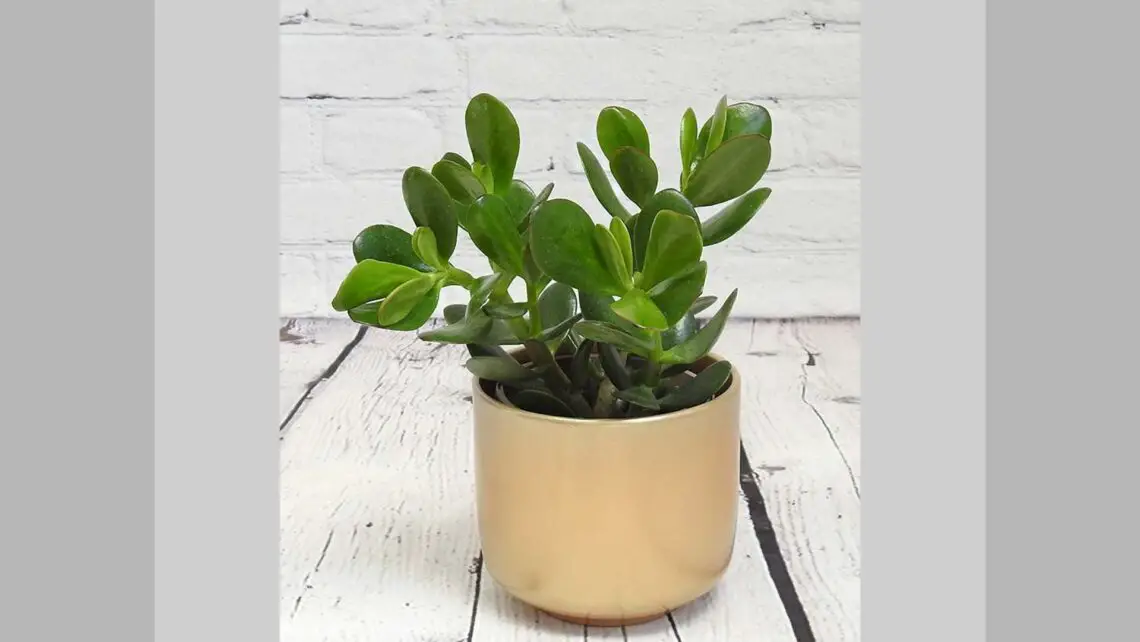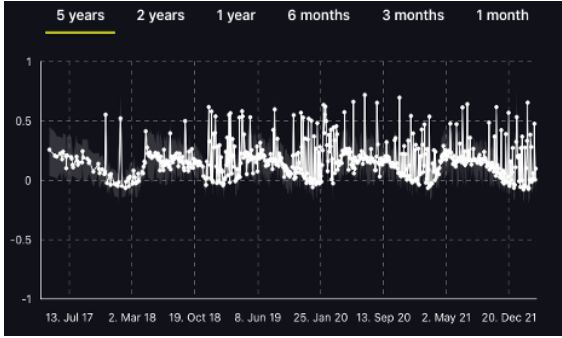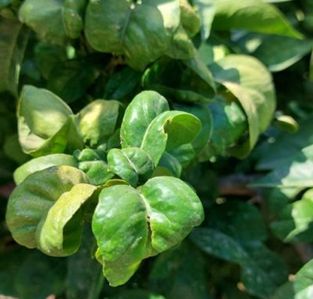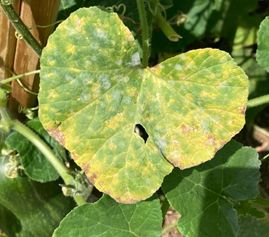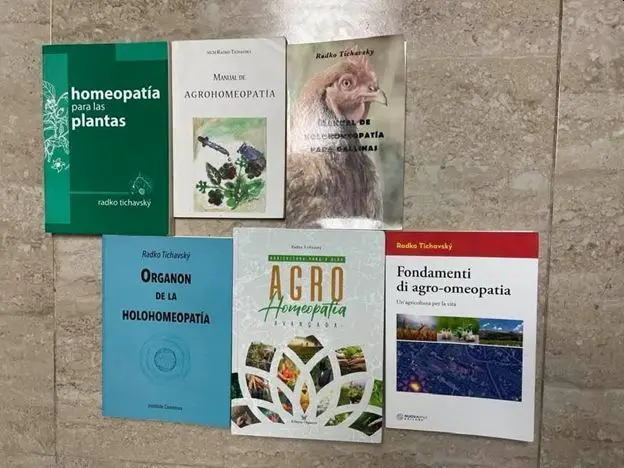New Video from Dr. Radko Tichavsky!
In this video, renowned Agrohomeopath Dr. Radko Tichavsky explains Holohomeopathy, the more advanced method of agrohomeopathy: https://youtu.be/GUUoO6Lt-U8 (English subtitles)
Course: He is now offering a one-semester virtual diploma course in Holohomeopathy (in English). Learn how to analyze holons and how to repertorize the specific homeopathic treatment beyond just disease or pest names. To learn more: www.icomenius.edu.mx Contact: [email protected]:
Editor’s Note: JT (Jenichen/Tichavsky) potency is often mentioned in these columns. It is a centesimal dilution followed by 500 succussions or five hundred continuous turns with a wooden stick to the right and 500 turns to the left (if handling larger volumes). The JT potency frequently has a better reaction in plants and it is very important in preparation of live bionosodes.
Dear Dr. Tichavksy,
Argyresthia conjugella (the apple fruit moth,) are eating all my apples. Is there anything I can do? We’re in North Carolina (U.S.) 28269. We have a humid climate with very warm summers and moderately cold winters. Rainfall 40 inches.
Thank you
Joseph
Dr. Radko Tichavsky:
Dear Joseph,
Argyresthia conjugella is an exotic pest that is attracted to apple trees by means of secondary metabolites, chemical compounds produced by the trees themselves but also by means of mVOC (Microbial Volatile Organic Compounds), in this case: 2-phenyl ethanol, methyl salicylate, and decanal plus a mixture of anethole and 2-phenyl ethanol that forms a powerful combination of attractants for the adults (males and females) of A. conjugella: 2-phenyl ethanol which is produced by a wide variety of bacteria and fungi including Aspergillus spp. Chaetomium spp., Fusarium spp. and bacteria, most especially from the families Burkholderia spp. Serratia spp. Staphylococcus spp. and also includes a few species of Bacillus spp.
That is, although apple trees naturally emit metabolic signals that attract this pest specifically to them, it is also true that certain varieties of apple trees are immune to this pest or less prone to it and this depends mainly on the composition of the microbiota. And among bacteria and fungi there are species that have a strong antagonism against apple fruit moth attracting microorganisms, such as Pseudomonas fluorescens.
Carrot has high metabolic similarity with apple trees and contains multiple metabolites in common and this similarity is reflected in a high coincidence of similarity of their microbiota.
However, the metabolites and microorganisms they do not have in common benefit both crops mutually. Pseudomonas putida and Pseudomonas fluorescens can be found in the root system of carrot (Daucus carota) and are the key microorganisms to control bacterias and fungus attracting Argyresthia conjugella.
Prepare live bionosode in carbonated water (water with CO2 bubbles) and apply dynamized (in non-chlorinated water) at 4 JT potency on the soil of your trees 40-100 liters per hectare on the soil (either in drip irrigation or sprayed on the soil).
Another factor that influences the availability of the trees to the pest is the humidity. I am sending you a soil moisture statistic for the last five years specifically for your area and you can see that the precipitation is above the comfort zone for apple trees (1000 mm per year) and the same happens with the temperature in summer that produces seasons with high temperatures (between 29 and 35 degrees Celsius) that stresses the trees and at the same time accelerates the proliferation of fungi and bacteria that attract apple fruit moth pests.
We cannot modify the climate, but we can induce a systematic resistance of the trees to these conditions of biotic stress, applying live bionosodes with antagonistic microorganisms, combined with homeopathic remedies.
Apple fruit moth has some predatory beetles (Pterostichus sp. and Harpalus latus for example) and staphylinids able to detect and eat apple fruit moth pupae. These are found on the ground beneath the tree (Aug/Sept-May/June) and their predation in these months is key to diminish the pest.
Also the braconid wasp, Microgaster politus Marsh is an important predator that can be attracted to your holon by bionosode from apple fruit moth larvae at 12 JT potency.
Prepare alcoholic mother tincture and dynamize. The last two dynamizations are done in water (not chlorinated) and applied as a spray on the trees and on the soil (40 liters per hectare approx.). It is enough to apply once a month during the active vegetative period of the trees.
It is important to know that apple fruit moth hibernate on the ground as a larva or a pupa and as far as we know spiders and ants did not eat apple fruit moth pupae. Formic acid and tiglid acid attract the enemies of the pest.
The first is found in Stevia rebaudiana (from TM in alcohol) and also in the fruits of Juniperus communis (from TM in alcohol) and the second is present in the essential oil of Pelargonium graveolens.
The remedies are prepared at 4 JT potency and applied on the ground, precisely at this time. During wet seasons apply Natrum muriaticum 12 CH once a month.
Greetings Dr. Tichavsky,
My orange trees never grow tall and their leaves are growing curved (pics attached). We live in Hendry County Florida (34142). Average summer temperature 80 F. Hendry County, Florida gets 51 inches of rain, on average, per year.
Thank you
Marvin
Dr. Radko Tichavsky:
Dear Marvin,
There can be four causes of leaf curling in orange trees: insects: aphids, mites, leaf miners, psyllids or scales, fungi: Botrytis spp. for example, water stress, and the fourth cause can be HLB (“greening”).
The first three conditions are relatively easy to correct, but the fourth is a major systemic condition. Florida is an endemic area for HLB disease (caused by gram-negative Candidatus liberbacter and also with some phytoplasma cooperation), which not only affects the leaves but also produces deformed fruit.
If the leaf curling pathology is due to the presence of insects you can apply Azadirachta indica 6 JT, prepared from essential oil of neem tree (Azadirachta indica). To find out if the leaf curl is caused by Botrytis spp. it is necessary to check the trees and verify if there is any damage to the bark, and especially if a kind of velvety gray mold appears on the trunk.
In this case, apply Silicea terra at 6 CH potency and the homeopathic preparation Echisetum arvense 6 CH. It is sprayed on the foliage of the trees, and the last two potencies are dynamized in non-chlorinated water with Opuntia ficus indica slime as an adjuvant.
Add 1 liter of Opuntia ficus indica slime for each 200 liters of dynamized preparation and apply 50-100 liters per hectare in a very fine drop disperser.
If leaf curl is caused by water stress, apply live bionosode of Opuntia ficus indica 6 JT, prepared from the sap of the cladodes. Place three or four Opuntia sp. cladodes, cut them with a knife in a bucket of water and leave them there for 12 hours.
Then you separate the cladodes from the sap of the plant and from there prepare the homeopathic dynamization. The remedies are applied by spraying on the leaves and also on the foot of the trees.
If it is HLB caused by Candidatus liberbacter and transmitted by Diaphorina citri, a tiny sucking insect that perches at 45 degrees on citrus leaves and transmits the disease, it is an endemic disease in Florida for which there is no definitive cure.
HLB is recognized by asymmetric yellowing of leaves that start at the top of the tree and gradually spread downward causing leaf and branch death and production of deformed fruit.
It causes a gradual deterioration of citrus and can be delayed with the application of salicylic acid 6 CH, vitamin C 6 CH and foliar nutrition as well as root nutrition with vermicompost fertilization.
On the other hand, the presence of the insect transmitter (Diaphorina citri) must be reduced with applications of Azadirachta indica 6 CH (made from essential oil).
As for the bacteria antagonistic to Candidatus liberbacter, six are used: Paenibacillus validus, Lysinibacillus fusiformis, Bacillus licheniformis, Pseudomonas putida, Microbacterium oleivorans, and Serratia plymutica.
In Florida weather conditions the useful bacterium (it is very resistant to high heat conditions) is Bacillus licheniformis. It is found in the droppings of ducks, but also of other aquatic birds.
Recover some duck droppings and prepare live bionosode (in non-chlorinated water) at 6 JT potency and apply on the soil around the trunks.
Hello Dr. Tichavsky,
By mistake I planted my hydrangeas on a spot that has too much sun. I will replant them shortly. What homeopathic remedy could help them recover? I live in Fayetteville Arkansas U.S. (zip 72701), We get 47 inches of rain, on average, per year. The climate is humid subtropical.
Thank you
Shirley
Dr. Radko Tichavsky:
Dear Shirley,
Hydgrangea spp. require an acid soil with pH less than 5.5. You could add a little apple cider vinegar to the irrigation water. You can also apply dynamized vitamin B complex at 3 JT potency (in water) to boost the collaboration of beneficial bacteria in the root system. Phosphorus 6 CH and live bionosode from soybean sprouts at 6 JT potency will help the plant to improve photosynthesis and produce new shoots.
Dear Dr. Tichavsky,
Is there any way to treat soil that is infected with club root? We have been unable to grow Brassicas with any success as the ground has clubroot in it. We are in Norfolk, UK. Postal code NR 14. Sept high 66 / low 49 F. Precipitation 26 inches /year.
Thank you
Charles
Dr. Radko Tichavsky:
Dear Charles,
The fungus Plasmodiophora brassicae (club root) requires several parallel interventions to be controlled as the fungus once established in the area can remain in the soil for more than twenty years.
My first suggestion is to maintain correct crop alternation. Before sowing the Brassicaceae, the Solanaceae family (tomatoes, eggplants) works well and after the Brassicaceae you can establish barley, oats or wheat for example.
The soil in the Norfolk area is largely free draining and slightly acidic loam, and these characteristics facilitate the establishment of P. brassicae. To correct these characteristics you can apply Ganoderma lucidum, or Phellinus nigricans (you can find them on trunks of Betula sp.) or Phellinus linteus (the last two species are easy to find in your area in oak trees) at potency 6 JT (prepared from mother tincture or if there are no trees in the area you can even apply in dynamization made from a hydrolat (crushing the fruits of the fungus in water leaving it to hydrate for two or three days, two or three applications of potency 6 JT are made two weeks apart alternating with Calcarea carbonica 6 CH in two-week periods for three months on the soil regardless of the crop (or even if the soil is in a resting state).
The next application consists of inoculation of Bacillus licheniformis and Bacillus amyloliquefasciens in the soil which will reduce the proliferation and inactivate the Plasmophora brassicae occupying its living space in the soil.
Bacillus licheniformis can be found in waterfowl droppings (e.g. ducks), prepare live bionosode at potency 12 JT made from a small sample of duck droppings, dynamize to potency 12 in non-chlorinated water (e.g. well water) and apply on the soil by sprinkling or irrigation.
As for Bacillus amyloliquefasciens, prepare a live bionosode at potency 12 JT from the roots of Hedera helix, a climbing plant that has this beneficial bacterium as its main endophyte. The live bionosode is also prepared in non-chlorinated water and you can add two liters of mineral water (with CO2 bubbles) for every 200 liters.
Additionally you can apply live bionosode of Trichoderma harzianum, a parasitic fungus that destroys Plasmodiophora brassicae by producing chitins, an enzyme that cleaves the fungal constituent chitin.
Trichoderma harzianum is found in the surface mulch of Alnus spp., Populus spp. or Fagus sylvatica, take a small sample and prepare a live bionosode at potency 4 JT (in non-chlorinated water) and apply on one occasion this autumn (approximately 200 liters of homeopathic preparation per hectare).
The seeds of cruciferous plants should be hydrated in Sulphur 6 CH before sowing and you should avoid or limit as much as possible the use of any nitrogen fertilizer (either of chemical or natural origin) because excess nitrogen acidifies the soil and creates conditions for the proliferation of the fungus P. brassicae and produces soft tissues that facilitate the entry of hyphae in the roots.
Hello Dr. Tichavsky,
Is there a homeopathic remedy that can bring back a cantaloupe plant from bacterial wilt?
Thank you
Angie
Hi Dr. Tichavsky,
How can I keep my butternut squash and cucumbers from dying? The leaves look like this (below). Our garden is in Delaware (Eastern U.S.) 19702.
Thank you
Alicia
Radko Tichavsky:
Dear Alicia,
The vital condition of Squash plants depends a lot on soil conditions and soil characteristics. Squash plants require very well-drained soils, because in poorly drained clay soils, water accumulation causes fungal diseases that are difficult to control.
You can add river sand to your soil to improve drainage. For antifungal applications you can use Sulphur 6 CH, a homeopathic remedy constituent of cucurbits, as well as Allium cepa and Alium sativum sativum, (onion and garlic) in the 6 CH potency.
Calcarea carbonica 4 CH will help to harden the epidermis of the plant, both leaves and fruits, to protect them from the entry of pathogenic fungi.
Professor Tichavsky,
Can you give me your advice to combat Tingid lace bugs infestation on my Azaleas which have been weakening from this attack since the end of July.
Thank you
Roberto Migliorelli
Dr. Radko Tichavsky
Dear Roberto,
The Tingidae are a family of very small insects in the order Hemiptera that are commonly referred to as lace bugs and attack mainly Azaleas (Rhododendron spp.). Most probably it is Stephanitis pyrioides.
The species is probably native to Japan and has been accidentally introduced in many countries of the world. For the control of this pest we use essential oil of Angelica dahurica or Angelica pubescentis or Angelica achangelica at potency 4 JT dynamized in water with an emulsion of 20 drops of essential oil per liter of water.
One uses application of Silicea terra at a cluster of potencies to induce the systemic resistance of Rhododendron spp. plants to this pest. A Silicea terra potency cluster has to be prepared, (also sometimes called a “potency chord”), in this case the combination 4-6-12 JT can work very well.
S.pyrioides has an important predator, Chrysopa spp. and Chrysoperla spp. (“lacewing”) which are powerfully attracted by acetophenone, a substance naturally found in several plants (Trifolium pratense flower, Hypericum perfortum) but mainly concentrated in the fruits of Piper nigrum (common black pepper), which contains up to 5000 ppm of acetophenone.
You can prepare an oleate of black pepper and apply it as a spray on the plants (it is important to avoid this application in the hot season as it can burn the plants). In the hot season, prepare black pepper essential oil (by distillation) and apply 2-3 drops per liter of water by dynamizing the emulsion to 4 JT potency and apply foliar application with Opuntia sp. slime as a coadjuvant.
You can also attract Chrysopa spp. with acetic acid, from the fruits of Juniperus communis, cocoa powder (Theobroma cacao), or flax seeds (Linnum usitatissimum) by preparing TM and dynamizing at 4 JT potency.
Another alternative to control S. pyrioides is to use Bacillus thuringuensis, or Beauveria bassiana (spraying live bionosodes on the leaves). Systematically you can use Azadirachta indica 4 JT made from essential oil of Azadirachta indica drenching the soil of the plants.
SEND your questions to: [email protected] by the 6th of each month.
BOOKS ON HOLOHOMEOPATHY
Many readers asked about Radko Tichavsky’s books. Below is a photo of them. They are available in Spanish, Italian and Portuguese. For ordering or information: [email protected]
Dr. Radko Tichavsky is a Czech born Mexican Agrohomeopath. He is a co-founder and director of Instituto Comenius in Mexico and author of Handbook of Agrohomeopathy, 2007 (Spanish) and Homeopathy for Plants, 2009 (Spanish), Organon de la Holohomeopatía and creator and teacher of Holohomeopathy.

